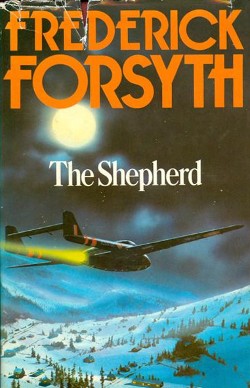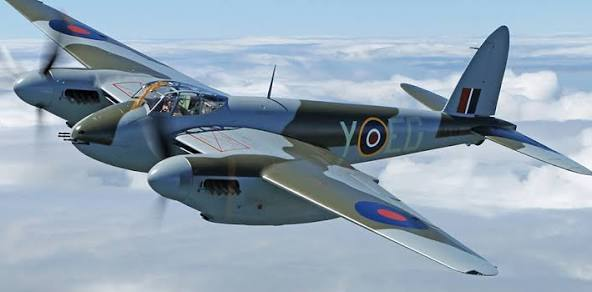
“Pilots are a rare kind of human. They leave the ordinary surface of the world to purify their soul in the sky, and they come down to earth only after receiving the communion of the infinite.” – Jose Maria Velasco Ibarra
* * *
“Flying isn’t dangerous. Crashing is what’s dangerous.”
* * *
My husband and I have an audio recording of The Shepherd, a novella by Frederick Forsyth. It tells the story of a young R.A.F. pilot whose night flight in his DeHavilland single-seat Vampire jet fighter went terribly wrong.
The entire story is voiced in first person by the unnamed pilot, played on the audio by actor Robert Powell, who gives the character just the right combination of charm and mild aviator arrogance.
The book begins as the pilot explains it’s Christmas Eve, 1957, and he’s on his way from Germany to Great Britain to spend the holidays with his family. He communicates with the tower and takes off into the night sky.
Forsythe lures us into the routineness of the voyage by having the pilot relate some inflight parameters: “… course 265 degrees, continue climbing to 27,000 feet… keep speed to 485 knots… Sixty-six minutes flying time with the descent and landing, and the Vampire had enough fuel for over eighty minutes in the air.”
He reaches his assigned altitude and continues his account of the uncomplicated journey: “Somewhere beneath me in the gloom the Dutch border would be slipping away, and I had been airborne for twenty-one minutes. No problem.”
The audio pauses for a few seconds, then this: “The problem started …”
Over the next chapters, various aircraft instruments fail because of an electrical fuse blow-out. By the time the pilot has identified all the problems, he can’t return to Germany because he doesn’t have enough fuel. He needs assistance to fly to his destination because his compass is not operational, but he can’t contact the airbase in Great Britain because the radio is out. On a disaster scale of one to ten, this about a nine-and-a-half, but he’s banking on his knowledge of the pattern of lights on the ground in Great Britain to lead him to his destination airfield.
He starts to descend to prepare for reaching the coast of Great Britain when the disaster scale hits ten. “At 15,000 feet and still diving, I began to realize that a fresh, and for me the last, enemy had entered the field.”
A low-lying fog has drifted in and blankets the earth under him. He cannot see the lights on the ground, and he can’t fly below the earth-hugging fog. He’s run out of options. He will have to keep his aircraft over the North Sea to avoid crashing into a populated area. When the plane runs out of fuel, he will bail out, knowing that will lead to certain death in the freezing waters below.
But there’s one last straw to grasp. His flight trainer had instructed the class that in a case of dire emergency (like this one), a pilot should fly a triangle pattern in hopes that a nearby air base would send up a shepherd plane to guide the wounded aircraft down. A shepherd that had radio and radar equipment which made it capable of guiding a disabled fellow pilot down to the runway even in poor weather conditions.
Our pilot flies the triangle pattern, but no shepherd appears. With his fuel gauge and his hope hovering just above empty, he spots a shadow on the fog bank. Another plane.
It’s a WWII propeller-driven fighter-bomber known as the DeHavilland Mosquito.

When the shepherd plane pulls up beside the fighter, its goggled and leather-helmeted pilot signals to fly in formation.
They descend through the fog layer while the Vampire pilot fears the worst. Gray cotton candy-like strands of cloud obscure everything except the aircraft off to his left. The fuel indicator is on zero. A cold sweat runs down his back. He is in a field of nothingness. This is the end. Then suddenly, he spots lights rushing by on each side of his aircraft. A runway! The plane settles down on the surface and rolls to a stop, out of fuel.
It seems like that should be the end of the tale. Our attractive main character faced the threat of death, fought the odds, gave up hope, but then encountered a shepherd airplane that brought him to safety beyond all odds. The reader is ready for the denouement.
But it isn’t the end. It’s only the beginning.
* * *
And to make an end is to make a beginning. —T.S. Eliot
The Shepherd is an example of a story with a false ending. The reader or listener is expecting the story to end, but instead, a new plot begins.
In an article in Writers Digest, Robert McCaw addresses the uses of the false ending.
“Another of my favorite techniques is the false or penultimate ending. In this case, the narrative comes to a neat close… There are no loose strings. The story is over, except it’s not. Instead, another chapter surprises the reader with a new and different take on the ending, often creating the opportunity to begin a new story…”
In the case of The Shepherd, the mystery begins as the Vampire pilot tries to discover who the pilot of the shepherd plane was and how he successfully guided him down. He makes one assumption after another, and each is proved wrong. The reader/listener is as confused as the young pilot.
I won’t spoil the ending, but it’s worth the read or listen to understand how to pull off this kind of effect.
* * *
We saw a movie years ago entitled Lives of Others that I think would qualify as a film with a false ending. It was a story about East Germany’s secret police, the Stasi, spying on East Berlin residents. As the movie approaches the climactic moment when the Berlin Wall comes down, one of the main characters, a Stasi agent, walks away from his job. At that point, I thought the movie had wrapped up all the loose ends and was over, but it continued to reveal secrets afterward. It was very effective.
There are other novels and movies that have false endings. Some that I read about (but haven’t read or seen the movie) are The Lord of the Rings: the Return of the King, and Spider Man 3.
* * *
So TKZers: Have you encountered the false ending in any books or movies? Have you used a false ending in any of your works? What do you think about this technique?
* * *

